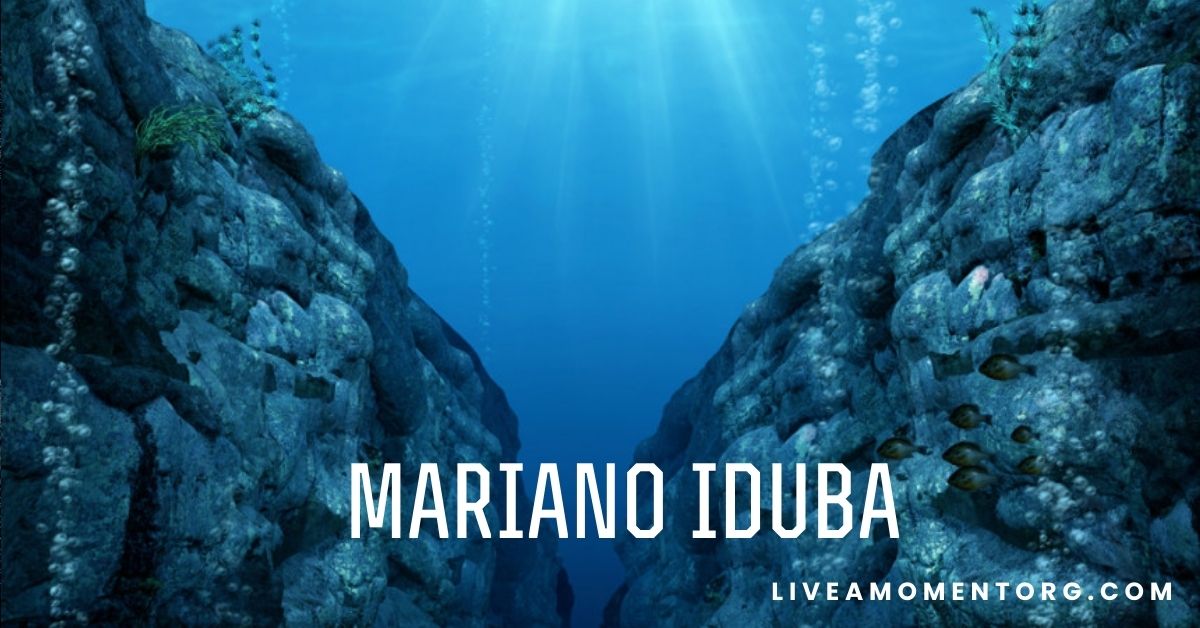Mariano Iduba: Unveiling the Mysteries of the Mariana Trench
In the vast expanse of the Pacific Ocean lies a phenomenon that has captivated scientists and ocean enthusiasts alike—the Mariana Trench. This trench is not just a geographical feature; it is a gateway to understanding the complexities of our planet’s oceanic systems. Within this enigmatic trench, a curious element known as “Mariano Iduba” has sparked intrigue, leading to numerous studies and explorations. The significance of Mariano Iduba extends beyond mere curiosity; it touches on important themes in oceanography, ecology, and even climate science. This article aims to explore the significance of Mariano Iduba, its characteristics, and the implications of the discoveries made in this underwater wonderland.
What is Mariano Iduba?
Mariano Iduba refers to a sound phenomenon that emerged from the depths of the Mariana Trench, the deepest known point in the Earth’s oceans. For nearly a decade, scientists have been puzzled by this mysterious sound, which has been described as both eerie and fascinating. The sounds originating from the Mariana Trench have been detected and recorded by various oceanographic research teams. Despite extensive studies, the true nature and origin of these sounds remained elusive, sparking numerous theories and hypotheses.
The Nature of Mariano Iduba Sounds
The sounds attributed to Mariano Iduba are not just random noises; they carry specific frequencies and patterns that have led researchers to hypothesize about their source. Some recordings show a series of low-frequency pulses, while others exhibit a more continuous hum. These sounds are distinct from the typical marine life noises like whale songs or the sounds of waves crashing against the seafloor. The unique characteristics of Mariano Iduba have made it a focal point for researchers trying to decode the mysteries of the deep ocean.
The Mariana Trench: A Brief Overview
Geological Formation
The Mariana Trench is located in the western Pacific Ocean, east of the Mariana Islands. It reaches depths of approximately 36,000 feet (about 10,900 meters), making it the deepest oceanic trench in the world. The trench’s extreme conditions, including immense pressure, low temperatures, and complete darkness, create an environment unlike any other on Earth.
The trench was formed by the subduction of the Pacific Plate beneath the smaller Mariana Plate. This geological process is responsible for the trench’s incredible depth and unique geological features. The trench is a testament to the Earth’s tectonic activity and provides a natural laboratory for studying geological processes.
Historical Context
The Mariana Trench has been the subject of scientific curiosity for centuries. However, it wasn’t until the late 20th century that serious explorations began. The first successful manned descent into the trench was made by Jacques Piccard and Don Walsh in 1960 aboard the bathyscaphe Trieste. Their mission opened the door to further exploration and research, culminating in numerous studies that continue to this day.
Geographical Context
The Mariana Trench stretches over 1,550 miles (2,500 kilometers) and is part of a larger system of trenches known as the Mariana Arc. This unique geographical feature plays a crucial role in understanding tectonic activity and the geological processes that shape our planet.
Surrounding Oceanic Environment
The trench is surrounded by a complex ecosystem that supports a variety of marine life. The waters above the trench are teeming with phytoplankton, zooplankton, and various fish species that form the base of the oceanic food web. As one descends into the trench, the biodiversity changes dramatically due to the extreme conditions.
Ecological Significance
Understanding the geographical context of the Mariana Trench helps highlight its ecological significance. The trench serves as a habitat for unique species adapted to survive in extreme pressure and low-light conditions. The study of these organisms can offer insights into evolutionary processes and the potential for life in other extreme environments, such as those found on other planets.
Biodiversity in the Depths
Despite the harsh conditions, the Mariana Trench is home to a surprising array of life forms. Scientists have discovered various organisms adapted to the extreme environment, including unique species of fish, crustaceans, and microbial life. These discoveries have opened new avenues for research in marine biology and ecology, as scientists strive to understand how life can thrive in such inhospitable surroundings.
Unique Species
- Amphipods: These shrimp-like creatures have garnered attention due to their ability to withstand high pressure. One species, known as the “deep-sea amphipod,” has been found at depths greater than 36,000 feet.
- Giant Squid: While not exclusively a trench dweller, the giant squid has been associated with deep-sea environments. Its elusive nature has made it a subject of fascination for scientists and enthusiasts alike.
- Deep-Sea Jellyfish: Various jellyfish species have adapted to the conditions in the trench, exhibiting bioluminescence that helps them attract prey in the dark depths.
- Microbial Life: The trench also hosts a diverse array of microorganisms that play essential roles in nutrient cycling and energy flow within the ecosystem.
Adaptations to Extreme Conditions
The life forms in the Mariana Trench exhibit remarkable adaptations that allow them to thrive in conditions that would be hostile to most known species. These adaptations include:
- Pressure Resistance: Organisms in the trench possess specialized cellular structures that enable them to withstand the immense pressure found at such depths.
- Bioluminescence: Many deep-sea species have evolved the ability to produce light, which helps them attract prey or communicate with others in the dark.
- Slow Metabolism: Life in the trench often relies on slow metabolic processes, allowing organisms to conserve energy in an environment where food is scarce.
The Mystery of Mariano Iduba
Initial Discoveries
The first recordings of the sounds attributed to Mariano Iduba were made in the early 2010s. Oceanographers began noticing unusual acoustic signals emanating from the trench during deep-sea exploration missions. These sounds were distinct from those typically recorded in the ocean, leading researchers to speculate about their origin.
Theories and Hypotheses
Numerous theories have been proposed regarding the source of the Mariano Iduba sounds. Some scientists suggested that they could be related to geological activity, such as underwater earthquakes or volcanic eruptions. Others posited that the sounds might originate from the unique behavior of deep-sea creatures or even interactions between the ocean and the Earth’s crust.
Geological Activity
One of the leading theories is that the sounds are linked to the movement of tectonic plates. The Mariana Trench is an active geological site, and seismic activity could produce the acoustic signals observed. Understanding the relationship between these sounds and geological events could provide valuable insights into the dynamics of the trench.
Biological Sources
Another hypothesis suggests that the sounds might originate from the unique behaviors of deep-sea organisms. Some researchers believe that the vocalizations of certain species could be responsible for the acoustic phenomenon. Identifying the specific organisms contributing to these sounds could lead to new discoveries about deep-sea communication and behavior.
Recent Breakthroughs
In recent years, advancements in technology and deep-sea exploration have allowed researchers to gather more data on Mariano Iduba. In 2021, a groundbreaking study revealed that the sounds could be linked to the movement of tectonic plates and the geological processes occurring in the trench. This revelation marked a significant milestone in understanding the complexities of the Mariana Trench and its acoustics.
Impacts on Oceanography
The discoveries related to Mariano Iduba have implications for oceanography as a whole. Understanding the sounds and their sources can enhance our knowledge of ocean dynamics, including current patterns and the behavior of marine life. This knowledge is essential for predicting environmental changes and managing marine resources effectively.
Implications of Mariano Iduba
Understanding Ocean Dynamics
The discovery of Mariano Iduba has broader implications for oceanography and geology. Understanding the acoustic signals produced in the Mariana Trench can provide insights into the dynamics of underwater ecosystems and the geological activity occurring in the region. This knowledge is vital for predicting natural disasters and mitigating risks associated with tectonic movements.
Climate Change Studies
The acoustic phenomena observed in the trench could also be relevant to climate change studies. As the ocean absorbs excess heat and carbon dioxide, changes in temperature and pressure can influence marine ecosystems. Understanding how these changes impact deep-sea sounds could offer insights into the broader implications of climate change.
Conservation and Research Opportunities
The Mariana Trench is a fragile ecosystem that requires careful monitoring and conservation efforts. The insights gained from studying Mariano Iduba can help scientists advocate for protective measures to safeguard the unique biodiversity present in the trench. Furthermore, ongoing research efforts can lead to innovative solutions for preserving marine environments worldwide.
Conservation Efforts and Challenges
Current Conservation Initiatives
Organizations and governments worldwide recognize the importance of conserving the Mariana Trench. Initiatives such as establishing marine protected areas (MPAs) aim to minimize human impact and preserve the unique biodiversity found in the trench. These efforts involve collaboration among scientists, policymakers, and local communities to ensure sustainable practices in ocean management.
Challenges to Conservation
Despite the positive strides in conservation, challenges remain. Issues such as deep-sea mining, pollution, and climate change pose significant threats to the fragile ecosystem of the Mariana Trench. Ongoing research into Mariano Iduba and the trench’s biodiversity can provide valuable data to inform conservation strategies and policy decisions.
Frequently Asked Questions (FAQs)
What is Mariano Iduba?
Mariano Iduba refers to a sound phenomenon detected in the Mariana Trench, the deepest part of the world’s oceans. These sounds have intrigued scientists and sparked extensive research to uncover their origin and significance.
Where is the Mariana Trench located?
The Mariana Trench is located in the western Pacific Ocean, east of the Mariana Islands. It stretches over 1,550 miles and reaches depths of approximately 36,000 feet.
Why is the Mariana Trench important?
The Mariana Trench is important for several reasons, including its geological significance, unique biodiversity, and its role in understanding ocean dynamics and climate change.
What types of life are found in the Mariana Trench?
Despite the extreme conditions, the Mariana Trench is home to various life forms, including deep-sea amphipods, giant squids, and unique microbial species. These organisms have adapted to survive in high-pressure, low-light environments.
What are the potential impacts of Mariano Iduba on climate change?
The study of Mariano Iduba could help scientists understand how changes in ocean dynamics impact marine ecosystems and the broader implications of climate change on deep-sea environments.
Conclusion
Mariano Iduba is a remarkable phenomenon that encapsulates the mysteries of the Mariana Trench and the oceanic depths. As researchers continue to explore and uncover the secrets of this enigmatic sound phenomenon, we gain valuable insights into the complexities of our planet’s oceans. The implications of these discoveries extend beyond scientific curiosity; they touch on crucial themes of conservation, climate change, and the interconnectedness of life on Earth. Understanding Mariano Iduba and the unique ecosystem of the Mariana Trench is not only essential for marine science but also for our collective responsibility to protect and preserve our oceans for future generations.







